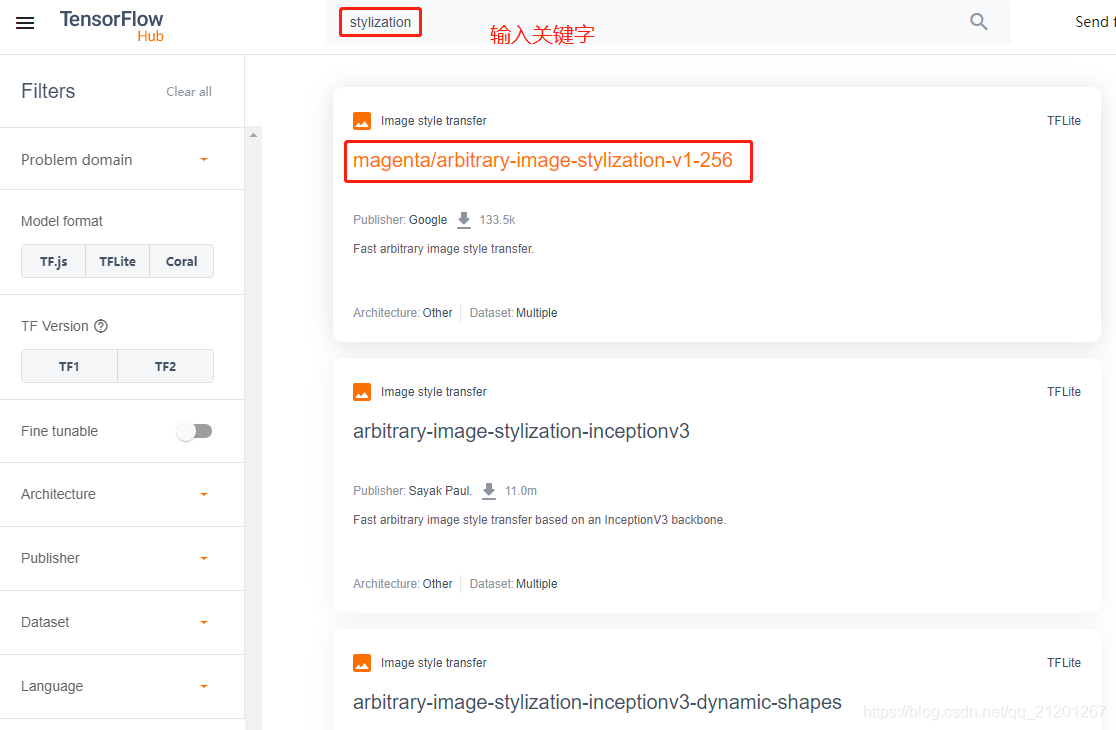热门标签
热门文章
- 1【网络安全---漏洞复现】shiro550反序列化漏洞原理与漏洞复现和利用(基于vulhub,保姆级的详细教程)
- 2springboot整合rabbitMQ系列6 死信队列演示,消息被拒绝(basicReject/ basicNack)并且不再重新投递到队列时requeue=false_delverytag重新投递不增加
- 3cuda学习笔记_ai,除了cuda生态,还是有什么
- 4优秀的 Linux 视频播放软件推荐(linux看视频软件)_linux视频播放器
- 5pymysql.err.ProgrammingError: (1064, “You have an error in your SQL syntax; check the manual that co_pymysql.err.programmingerror: (1064, "you have an
- 6基于Matlab实现图像融合技术(附上多个案例源码)_matlab案例
- 7IOS----macOS系统上安装,使用Git,常用可视化工具_mac安装小乌龟
- 8程序员高考试卷!你满分了吗?
- 9Python程序打包指南:手把手教你一步步完成_python 如何打包发布项目
- 10Quest 2 VR程序读取本地图片
当前位置: article > 正文
TensorFlow 2.0 - Hub 模型复用_tfhub labse2
作者:很楠不爱3 | 2024-05-03 23:17:09
赞
踩
tfhub labse2
1. tfhub
网址:
https://hub.tensorflow.google.cn/
https://tfhub.dev/
-
可以搜索,下载模型

-
安装包
pip install tensorflow-hub
import tensorflow_hub as hub
hub_url = 'https://hub.tensorflow.google.cn/google/magenta/arbitrary-image-stylization-v1-256/2'
hub_model = hub.load(hub_url) # 加载模型
outputs = hub_model(inputs) # 调用模型
- 1
- 2
- 3
- 4
- 5
2. 例子:神经风格转换
import tensorflow_hub as hub import matplotlib.pyplot as plt import numpy as np import tensorflow as tf # 归一化,resize def load_image_local(img_path, img_size=(256, 256)): # png 4 通道转 jpg 3通道 if 'png' in img_path: img = Image.open(img_path) img = img.convert('RGB') img.save("temp.jpg") img = plt.imread("temp.jpg").astype(np.float32)[np.newaxis, :, :, :] else: # 添加一个 batch_size 轴 img = plt.imread(img_path).astype(np.float32)[np.newaxis, :, :, :] if img.max() > 1.0: img = img / 255. img = tf.image.resize(img, img_size, preserve_aspect_ratio=True) return img # 绘制图片 def show_image(img, title, save=False, fig_dpi=300): plt.imshow(img, aspect='equal') plt.axis('off') plt.show() if save: plt.imsave(title + '.jpg', img.numpy()) # 图片路径 content_image_path = "pic1.jpg" style_image_path = "pic2.jpg" # 处理图片 content_image = load_image_local(content_image_path) style_image = load_image_local(style_image_path) # 展示图片 show_image(content_image[0], "Content Image") show_image(style_image[0], "Style Image") # 加载模型 hub_url = 'https://hub.tensorflow.google.cn/google/magenta/arbitrary-image-stylization-v1-256/2' hub_model = hub.load(hub_url) # 调用模型 outputs = hub_model(tf.constant(content_image), tf.constant(style_image)) stylized_image = outputs[0] # 取出第一个样本预测值 [ :, :, 3] # 展示预测图片 show_image(stylized_image[0], "Stylized Image", True)
- 1
- 2
- 3
- 4
- 5
- 6
- 7
- 8
- 9
- 10
- 11
- 12
- 13
- 14
- 15
- 16
- 17
- 18
- 19
- 20
- 21
- 22
- 23
- 24
- 25
- 26
- 27
- 28
- 29
- 30
- 31
- 32
- 33
- 34
- 35
- 36
- 37
- 38
- 39
- 40
- 41
- 42
- 43
- 44
- 45
- 46
- 47
- 48
- 49
- 50
- 51
- 52
- 53
- 54
内容图片:

风格图片:

转换后的图片:

3. retrain 例子
https://hub.tensorflow.google.cn/google/imagenet/inception_v3/feature_vector/4
hub.KerasLayer(url)封装一个layer到模型当中,可以设置是否 finetune
num_classes = 10
model = tf.keras.Sequential([
hub.KerasLayer("https://hub.tensorflow.google.cn/google/imagenet/inception_v3/feature_vector/4",
trainable=False), # 可以设为True,微调
tf.keras.layers.Dense(num_classes, activation='softmax')
])
model.build([None, 299, 299, 3]) # Batch input shape
model.summary()
- 1
- 2
- 3
- 4
- 5
- 6
- 7
- 8
模型结构
Model: "sequential"
_________________________________________________________________
Layer (type) Output Shape Param #
=================================================================
keras_layer (KerasLayer) (None, 2048) 21802784
_________________________________________________________________
dense (Dense) (None, 10) 20490
=================================================================
Total params: 21,823,274
Trainable params: 20,490
Non-trainable params: 21,802,784
_________________________________________________________________
- 1
- 2
- 3
- 4
- 5
- 6
- 7
- 8
- 9
- 10
- 11
- 12
声明:本文内容由网友自发贡献,不代表【wpsshop博客】立场,版权归原作者所有,本站不承担相应法律责任。如您发现有侵权的内容,请联系我们。转载请注明出处:https://www.wpsshop.cn/w/很楠不爱3/article/detail/532034
推荐阅读
相关标签



